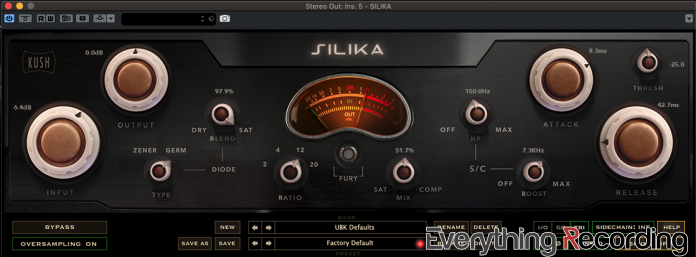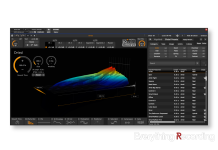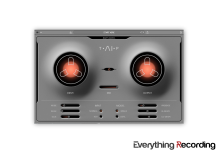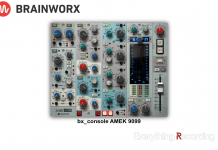- A virtual “PB&J” of germanium and zener diode sonics.
- Stunningly rich and nuanced, analog-esque sound.
- Great for “just a little” or “a whole damn lot”.
- Easy to over-use in the wrong hands.
- Stereo field gets smeared when pushed too hard.
- Slightly higher learning curve than other plug-ins.
We are decades-deep into the plug-in gold rush. By now we have more compressors, saturators, eq’s, expanders, modulators, delays, bitcrushers, synthesizers, samplers, virtual toy pianos and rhythmic oblongiscopic downglitch pixellators than anyone could possibly ever need. But they keep washing ashore here at our humble doublewide / global headquarters, so we keep reviewing ‘em.
On that note, it seems that about 90% of the vintage compressor plug-ins are based on either VCA-based or optical designs. But the 20th Century’s advent of recording technology has many overlooked examples of Edisonian experimentation: Esoteric, almost mythical pieces of rarely seen kit that are as hard to find as they are to afford. Check out Sylvia Massey’s control room – it’s a virtual freak show of pro audio’s oddities.
A notable example of this bygone era is the diode bridge compressor. Originally conceived as a way to make mid-century radio transmissions more intelligible, the Neve 2254 and the Neumann u73 found fans in the recording studio for its unique, wooly character. Comparatively noisy compared to the later VCA and vactrol-based designs, diode bridge designs have stayed largely off the main stage.
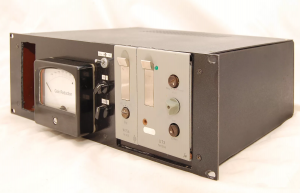
Another curio from your great-grandfather’s time in the war is the germanium transistor. Germanium is a curious one as it’s design intent was to amplify, but it softened and compressed louder signals as an unintended artifact. In other words, germanium’s bug is now a feature. Keep it civil and it’ll give you soft edges like a vintage sepia-toned photograph. But push the input 6db harder and you’ll get an increasingly girthy splat of your signal’s former self. Yes, tubes and diodes do that, too. But not quite like this.
WELCOME TO SILIKAN VALLEY
Kush Audio are a company that I trust more than just about anyone to modernize an old design. Why? Well, for one, they’re not just code crushers – they build actual hardware. Excellent hardware, in fact. For another, Kush keeps their sense of humor and adventure intact with their plug-ins. It’s not as clinical and by-the-numbers with this company when you put their stuff to work. Everything from their GUI to the gear itself has a way of reminding you, “Hey, idiot, we are supposed to be having fun right now. Stop agonizing over the milliseconds of your attack time and just listen.” (There’s another kind of kush that can help with that, too.)

In the spirit of that, our friends over there at Cannabis References, Inc. have just unleashed “Silika” on the world. ($99 USD*, PC (32/64bit), Mac (64bit only), VST/AAX/AU). Silika combines both the features and limitations of the diode and germanium circuits mentioned above – milling both their beauty and their beast into a whole new kind of cool. If a GML compressor is the trained young teacup poodle who sits on command, Silika is the mangy dog you found by the dumpster who smells like trash, but licks your face and really seems to like you.
(* You can either purchase a single in perpetuity license of Silika for $99, or get an annual license to the entire House of Kush bundle for the same price)
P-P-P-PUSH IT REAL GOOD
Silika’s interface bears the expected controls you’d find in any compressturator plug-in, letting you control input and output levels, threshold, ratio, attack, release, and so on. A single VU meter simultaneously displays the incoming and outgoing levels and the amount of gain reduction. On that, putting three needles into one VU is great for economy of space – but was definitely a little hard on my aging Gen X-eyeballs and short attention span.
But you’re also presented, if not confronted, with a few curious choices, such as zener and germanium (“zener” being the aforementioned diode bridge) on the input, a blend between saturated and compressed and a curious “FURY” button right below the metering that clearly wants you to push it. These take a bit of experimentation to find that storied “sweet spot” from source to source – so save your presets.
Additionally, you’re provided with an internal sidechain high-pass filter that will keep things like bass drums and other LFE-rich material from breaching the compressor’s threshold, or you can externally trigger from the source material of your choosing. This should be on every compressor plugin whether it was modeled on one without it or not. Once you’re without it, you miss it. Fast.
One thing that quickly becomes apparent in use is that, like an LA-2A or 1176, the real way to make Silika get busy is pushing the input gain and leaving the threshold and ratio alone. Need more squash? Hit it harder. Not quite there yet? Crank the input another turn. Don’t worry, we’re in a 64-bit world now, there’s headroom – just watch your output gain.
It’s the combination of the germanium transistor input stage and the diode bridge compression circuit that make Silika such a unique beast. Each of those features easily command a plug-in of their own. But having both at once with the ability to blend between the two is what makes Silika such a compelling option.
STORMING THE CASTLE
Once you hear what Silika brings to the table, every “flat”-sounding source will likely be getting a taste. We’ve all agonized over drum mixes or vocals that, due to operator negligence, inattention or inexperience, just felt somehow anemic. Sure, you can hear what’s happening, but there’s no excitement, nothing compelling to draw somebody in. That’s where Silika’s magic beans start growing. Lifeless drum overheads or room mics now possess a Bonham-esque bombast with a beefy-supreme low-end and delightfully crunchy top. Anorexic basses are strapped to a chair and force fed a double cheeseburger. Lifeless vocals are brought back from the dead with breathy presence and immediacy, letting you place the point-of-source in the listener’s ear canal if you want. It’s like giving your dog his testicles back after all these years.
As with most things in life however, there’s a fine line between doing and overdoing to be cognizant of here. The initial excitement of hearing a scrawny, inert performance grow fangs and howl at the moon can make even the most seasoned of engineers a little bit giddy with new-found power. “Season to taste” often means a dash or sprinkle, not screwing the top off of the pepper shaker. Pushed too hard, too much or too often can quickly take things from full to fatiguing. But if what you’re after is “compression as an effect”, by all means, thwack that “FURY” button (if you haven’t already) and Silika will kick out the jams accordingly. Anything’s fair game: loops, basses, congas… this plug-in’s an equal opportunity smackulator.
Surgeon General’s warnings aside, Silika can play nice… or not-so-nice. Drum busses and overheads gobble up Silika’s meaty sonics hungrily, but so do basses and low synths that need to reclaim their rightful place in the lower registers. If the track (or tracks) feel dimensionless, running Silika either full-on or as a parallel effect can really add the electricity that’s gone missing. As a master bus compressor, I’m a bit more hesitant to unleash its wrath – it seemed to smear the stereo image a touch. If you’re still inclined to try, use Silika’s blend knob as a parallel effect and work your way up. Done tastefully, Silika could be just the thing that turns “ho-hum” to “hell yeah”.
Like all good studio tools should be – Silika is whatever you want it to be. There’s no “right way” to use something like this properly – and even after tooling around several different sessions and genres, I kept finding new ways to bring its magic and its mojo into the fold. Yes, I said “mojo”. Sue me.
BRING THAT BEAT BACK
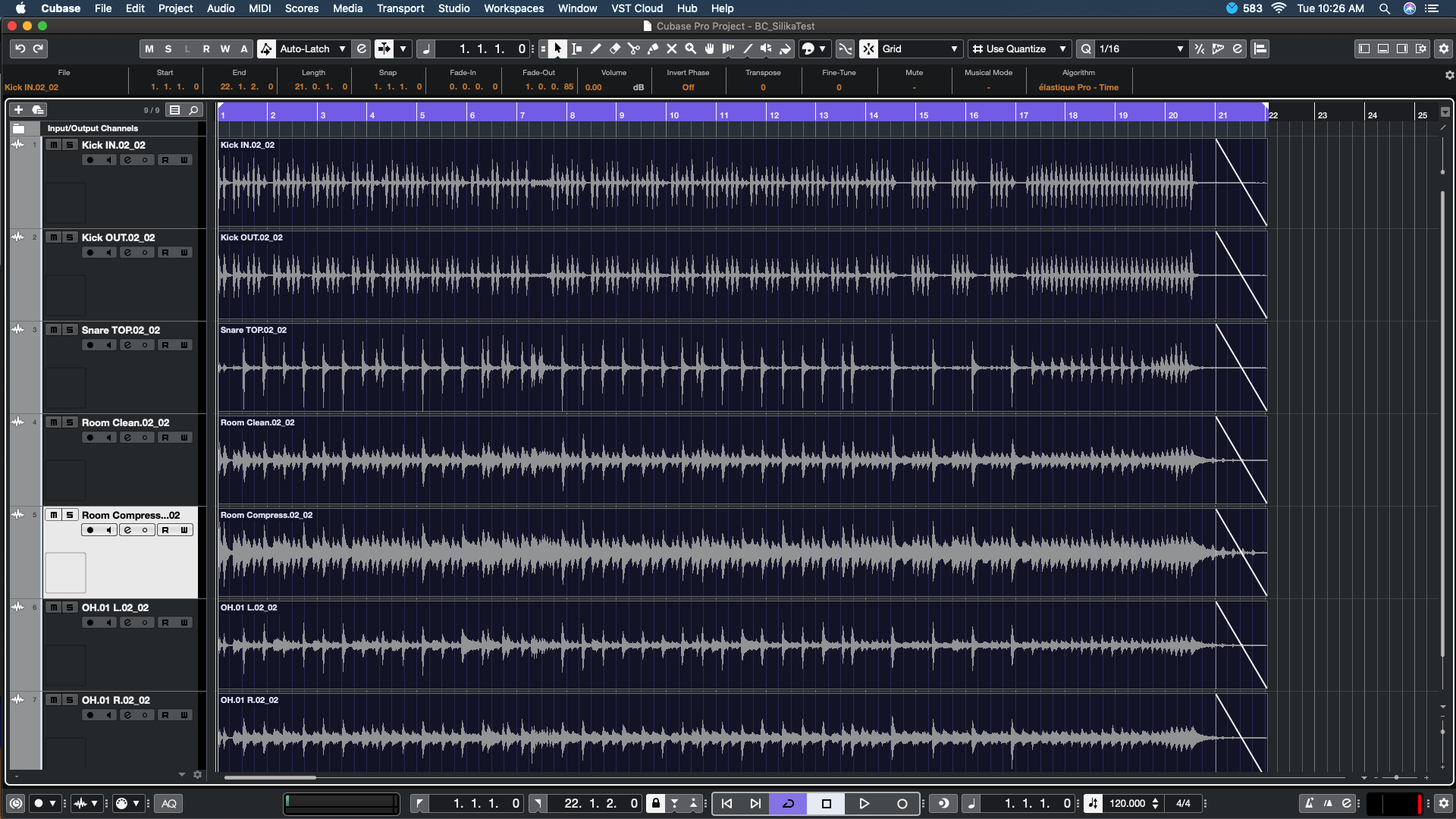
I pulled in a few pieces of an old multitrack, recorded through Downtown Recording‘s pristine Neve Melbourne side-console. And while these files were eventually given the usual time correction, sample replacing and processing for the client, I just threw in the kick, snare, overheads and mono room, set a couple of quick levels and strapped Silika across the master bus for a quick test drive.
While the original recording was well-represented, a thoroughly unprocessed mix doesn’t cut through the way the meticulously mixed and mastered results do. Dialing in just a bit of Silika’s germanium input and a few db of overall reduction from the compressor brought out the kit’s presence and a new layer of depth to the decay of each hit. You got more of a sense that what was happening was right in front of you.
Pushed a bit more liberally (and unable to resist that ‘Fury’ button), the drums became an untamed animal. A crunchy, analog smack elicited the 2″ 16-track days of long ago. Even the kit’s 20″ kick drum and 13″ snare, a far, far cry from John Bonham’s circus-sized monster Ludwigs, took on an indelible weight. They felt big. Heavy. Meaty. And definitely would propel a full band’s mix with their energy.

YOU CAN’T SPELL “ANALOG” WITHOUT “A – N – A – L”.
Whenever we evaluate a “classic” modeled piece of hardware or software, a big piece of the puzzle is how faithfully it’s able to recreate the sonics, the quirks and the eccentricities of the hardware that inspired it. Some do it far better than others, and for some reason the VCA-based designs seem to categorically get the closest. But at the same time, we also have take into consideration how it sounds in and of itself, regardless of the image on the interface. I can think of one particular API 2500 clone that, while being a swing and a miss in its emulation of this classic compressor, is still eminently useful.
To that end, Silika’s not particularly modeled on any one piece of hardware, but on a stew pot full of different designs. I hear shades of the Neve 33609, the ADR Compex F760 and EMI’s hallowed TG12413 mastering limiter, but it’s clear that Kush Audio is taking their inspiration to create their own thing. So while yes, you can evaluate a plug-in like this in many ways, a key metric is how much it replicates the “analogism”. To that end, Silika nails the silky highs, the presence in the high mids and booming rounded lows… it’s all right there.
At the risk of being pedantic, it really is just “the it factor” with something like Silika. If you close your eyes and just listen, do you get the sense that there’s a vintage powder-coated box adding hundreds to your electric bill? Does it impart that elusive warmth that we all try to avoid calling “warmth”? I found Silika extremely up to the chore – creating an intoxicating layer of analog shimmer and weight at responsible levels. Pushed to its limits and beyond, it continued to mimic its hardware brethren quite well – pushing the source material to snarl, heave and grunt its way to greatness.
SUPER SMASH BROTHERS
You’ll find a few other plug-ins that are adept for similar use. Tone Empire’s “Goliath” comes to mind, though its particular “hook” is emulating different types of output transformer core materials.
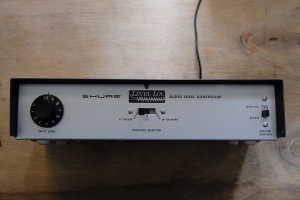
Sound Toys’ “Devil Loc” (a faithful reimagining of the Shure Level-Loc that found a new army of fans in the 1990’s) can also be deployed against shrug-inducing source material with enticing results.
Waves’ V-Comp and Lindell Audio’s 254E are modeled directly after the Neve 2254 and 33609 compressor’s zener diode topology and do so quite well – but lack the germanium-inspired input stage. And yes, even the lesser-known EMI TG12413 has been recreated for life in a digital world.
Kush Audio’s Silika does all of “those things”, but with the right amount of control in combining the saturation and compression. The sound is just as easy to reign in and use in a pleasing, useful way as it is to unleash holy terror on unsuspecting sources. To be honest, simply destroying your signal isn’t that difficult. Slapping it around until it sits just right needs bit more refinement – and Silika has that refinement in spades. Used a little or a lot, on one source or several, it teases the track’s excitement and energy out of hiding. With just a little bit of patience, Silika can help you saturate, clip and compress in a glorious, lush way.
There are hundreds of compression/saturation plug-ins out there. You have your vintage-modeled ones, you have your “never seen this before” ones – and somewhere in the middle you have the rare gem that bridges both. On the one hand, Kush Audio Silika’s sound may be inspired by a relic circuit from a bygone era, sure. But the way it’s been reinvented for today with a modern feature set gives you a whole new palette of sonic awesomeness to play with.
For more information and to purchase, visit https://thehouseofkush.com/products/silika



